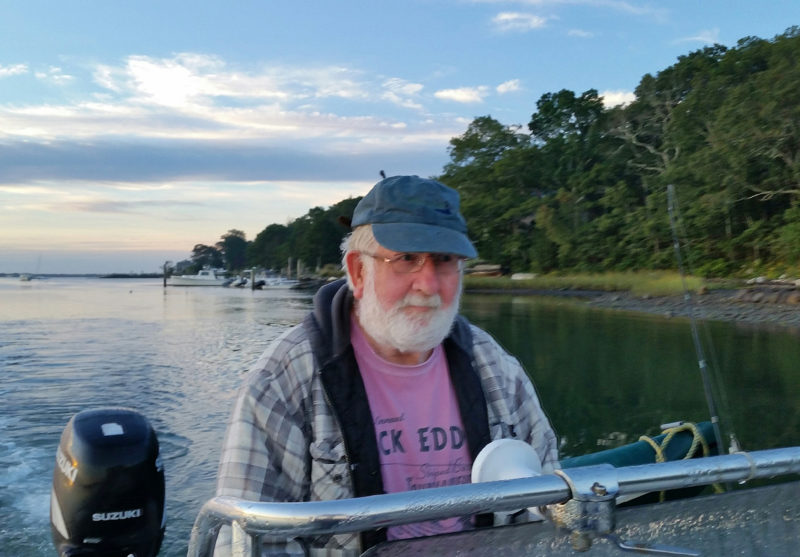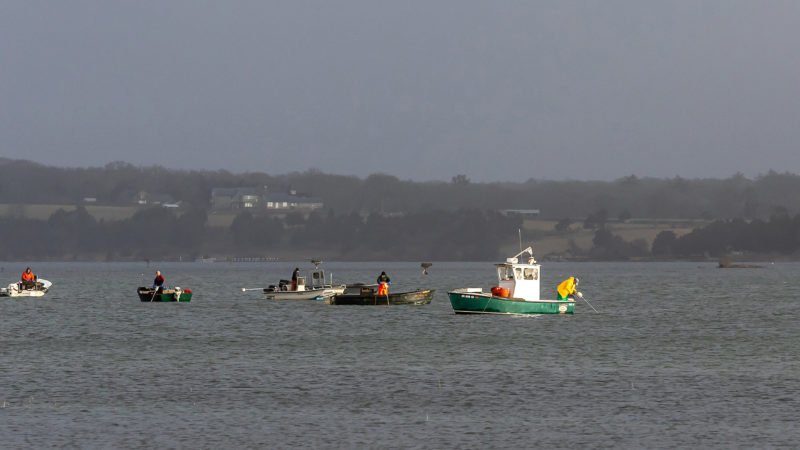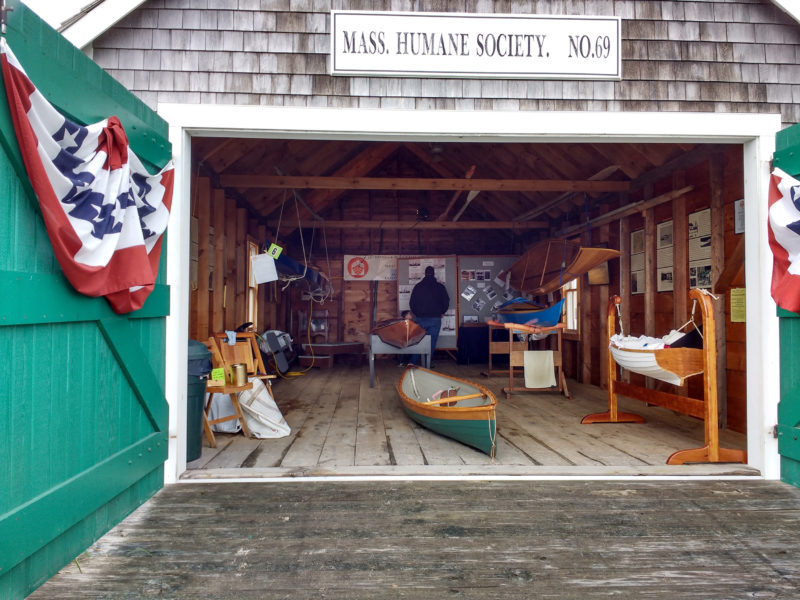Westport Fishermen’s Association leaves a legacy of clean water for the Westport River
If you ask Jack Reynolds, past president of the Westport Fishermen’s Association, about the organization’s legacy, he’ll tell you that there are still too many fish left to save and too much pollution to stop to save the Westport River. The WFA’s most important role, he contends, was to “shine a light” on the river’s pressing water quality issues.
But a quick list of the WFA’s 35-year history of action to protect the Westport River clearly shows what the organization accomplished: Creating a bacteria monitoring program that allowed the river’s closed shellfish beds to reopen. Stopping the largest-ever source of pollution to the river. Pushing for lasting state policy amendments that halted the threat of development near the river’s shoreline. Saving Buzzards Bay’s last remaining historic Life-Saving Station. And most recently, bringing to light the devastating disintegration of the river’s precious salt marsh islands.

Had the Westport Fishermen’s Association not been there to raise awareness and take action for the Westport River, “there would not have been a light shining on” these issues, says the organization’s past president and lifelong Westport fishermen Jack Reynolds.
“As far as water quality and habitat issues are concerned, the needs of the river are no less than when we started,” said Reynolds, a lifelong Westport fishermen who founded the WFA in 1983. “And they will continue to be an ongoing challenge as the town builds out and development pressure increases.”
Last October, the WFA merged with the Coalition, which has committed to carrying on the WFA’s legacy of action to reduce pollution and restore and protect aquatic habitats for the fish, wildlife, and people of Westport.
Reynolds explains that the merger made sense because the missions of the WFA and the Coalition were well aligned. “Our missions don’t have geographic boundaries. Whether you’re in Westport, Dartmouth, New Bedford…what the Coalition does helps everybody on the whole Bay.”
Although the WFA was started by commercial and recreational Westport fishermen like Reynolds, the organization ultimately became a driving force for grassroots advocacy to improve the health of the Westport River. Its hard-fought efforts over the past 35 years laid the groundwork for much of the river’s pollution reductions and public support for clean water in the town.
The WFA was established after the state Department of Environmental Protection – then called the Massachusetts Department of Environmental Quality Engineering (DEQE) – closed the entire river to shellfishing. “We were mad at the state,” Reynolds said. “So we formed a group to address the closing of the river.”
The state’s monitoring data had shown that the river’s bacteria levels were much higher than what’s considered safe for shellfish consumption. “The last word from DEQE was, ‘We don’t know when the river is going to open again – in other words, it was closed permanently.”
At the time, Massachusetts did not open and close shellfish beds on a conditional basis; shellfishing in a particular waterway was either open all the time or closed all the time. But in neighboring Rhode Island, the state had a system that would close some shellfish beds on a temporary or seasonal basis due to rainfall or other polluting conditions.
Armed with this knowledge, the WFA asked DEQE if Massachusetts could implement conditional openings like Rhode Island had. They said yes – but asserted they didn’t have the manpower to gather the data that would allow them to make decisions about conditional openings.
So to save shellfishing on the Westport River, the WFA decided to collect the data itself.

The Westport Fishermen’s Association was started in 1983 by commercial and recreational Westport fishermen. But the organization ultimately became a driving force for grassroots advocacy to improve the health of the Westport River. (Image: Greg Stone)
Using an approved regimen from DEQE, the WFA set up a laboratory in the basement of Town Hall to collect data about bacteria levels in the river. One of its members, Arnold Tripp, had a chemistry background and ran the program. He and others took water samples at the same spots on the river before and after rainstorms, and then recorded that data in a spreadsheet to show rainfall amounts, times, and corresponding bacterial levels.
At long last, the state accepted the WFA’s data in the 1990s and instituted conditionally approved shellfishing areas, which reopened most of the river to shellfishing. To this day, the water quality monitoring program originally designed by the WFA is still used to open and close shellfish beds on the Westport River depending on weather and pollution conditions.
However, the shellfishing closure led the WFA to ask a larger question: Why is the river polluted in the first place?
“When we started looking into the whys and hows of the closing, we learned the river was polluted,” Reynolds said. “And the only way we could reopen the whole river was to unpollute it.”
As the newly minted Westport Fishermen’s Association, Reynolds and his fellow members started looking into the problem of pollution in the Westport River. They discovered a few big sources, like failing septic systems, stormwater runoff, and agriculture. But after noticing the East Branch’s productive oyster beds north of Hix Bridge Landing were still permanently closed at the end of the 1990s, they pinpointed one particularly egregious source – which opened up a multi-year advocacy effort that ultimately led to its elimination.
The source was a 33-acre agricultural operation on Drift Road, about 100 feet from where the mouth of Snell Creek emptied into the river. The owner raised anywhere from 350 to 600 cows on the property – which turned out to meet the federal definition of a feedlot under the Clean Water Act.
Howard Gifford, whose family has lived and fished in Westport for generations, owns the property next door to the former feedlot. He recalls a time when he went for a walk down along the salt marsh that lined the edge of their properties – a place where the feedlot’s cows often stood in the water. “We were walking through manure that was 10 to 18 inches deep, just waiting for high tide to take it out.”
It was this manure runoff – and the loads of fecal coliform bacteria it carried – that was preventing the East Branch’s productive oyster beds from reopening to harvest.

The feedlot on Snell Creek was discovered to be polluting the Westport River with bacteria from manure – at amounts over 6,000 times the safe level for swimming and 85,000 times the safe level for shellfish consumption.
Gifford sent his story and photos of the marsh to as many people as possible, hoping something could be done about it. “That was my beginning with the Westport Fishermen’s Association,” he said.
WFA members stepped in to build a wire fence along Snell Creek to keep the cows at least 200 feet from the river’s edge. But the fencing wasn’t maintained, and the cows eventually got back into the water. Around the same time, the EPA issued a federal discharge permit – the first of its kind for any New England animal operation – that required significant cleanup measures, but the feedlot violated the terms of the permit.
By the spring of 2000, the feedlot was discovered to be polluting the creek with even more bacteria from manure – at amounts over 6,000 times the safe level for swimming and 85,000 times the safe level for shellfish consumption. “Whenever we tested the water for bacteria, the results would read ‘TNC: Too Numerous to Count,’” Reynolds said.
To finally put a stop to this egregious pollution source, the WFA teamed up with the Coalition to sue the feedlot in Superior Court. This tireless, years-long advocacy and teamwork led to a legal agreement that halted further pollution from the feedlot. A little over a year later, water testing showed that the East Branch was clean enough to harvest shellfish again. Thick oyster beds from Cadman’s Neck to Hix Bridge reopened for the first time in two decades.
It was actions like this that allowed WFA to stake a claim not just as a fishermen’s organization, but an effective environmental group. “There was a lot of collateral benefit to what we were doing,” Reynolds said. “If you clean up the river, it’s not just so some guy can go out and make a day’s pay. It helps everybody.”
The WFA also influenced state policy that has since and will continue to protect the shores of all the Bay’s rivers from development. In 1996, Massachusetts passed the Rivers Protection Act, which provided stricter protections to riverfront areas than the existing Wetland Protection Act: specifically, a greater setback from the water’s edge and no exemptions for development.
After the Rivers Act passed, a Westport property owner who wanted to build in the riverfront area argued that the Westport River’s tidal estuary did not fall under the act’s guidelines.
Reynolds was also a member of the Westport Conservation Commission at the time, and he saw the potential long-term implications of the decision. “We didn’t agree when they contested that the Westport River was not a river,” he said. “That would mean you would really see some development going on along the side of the river.”
After the conservation commission denied the application, the homeowner appealed the decision to MassDEP – which sided with the homeowner in saying that the tidal Westport River was not, in fact, a river.
“We made the argument: Look at what you’re doing here. You’re taking away hard-earned protection that the backers of the [Rivers Act] were sure of when it went into effect. They were thinking they were going to protect the river, and now you’re not,” Reynolds said.
The case took Reynolds and the WFA all the way to the State House to fight for the strictest protections for the Westport River. The secretary of environmental affairs, who has the final say on all of the state’s environmental decisions, ultimately decided in favor of the Westport Conservation Commission and formally declared the Westport River to be a “river.”
The Westport case set the precedent for the state’s enforcement of the Rivers Act. Under the secretary’s decision, MassDEP had to create maps for all of the state’s rivers showing the areas that fall under the jurisdiction of the Rivers Act. “I’ll call that a victory,” Reynolds said. “It was a good victory for the resources.”

The Westport Fishermen’s Association restored the historic Horseneck Point Life-Saving Station, the last of its kind on Buzzards Bay. It’s now being operated by the Buzzards Bay Coalition as a seasonal visitor center and museum.
Another victory of the WFA was saving the historic Horseneck Point Life-Saving Station, located near the causeway to Gooseberry Island, from demolition in the mid-2000s. Originally built in 1888, the Life-Saving Station was part of a larger network of stations across Massachusetts’ shores that were built to aid mariners in distress. It’s the last remaining Buzzards Bay station and one of only four left state-wide.
“I felt like the Life-Saving Station should be saved because it’s part of Westport history,” said Gifford, who was heavily involved with the project. “It was a way to attract attention to our efforts to clean the river.”
Between 2007 and 2009, the WFA brought the Life-Saving Station back to its original appearance and then opened it as a museum and visitor center. Its efforts helped to preserve an almost-forgotten piece of Westport’s rich maritime history and make it available to the public. (As part of the merger, the Coalition will now maintain the Life-Saving Station and open the visitor center seasonally from May to September.)
Most recently, Reynolds raised the alarm about disintegrating salt marshes in the Westport River. “I noticed the marshes were not the same as they were back in the 1970s when I used to fish the river. I thought, ‘There’s something going on here that’s just not right.’” His advocacy led to a 2016 Coalition-led study that found the river’s salt marshes have declined by nearly 50 percent over the past 80 years. The Coalition is continuing to carry on the project by expanding this research to a dozen new locations around the Bay to help guide efforts to halt these declines.
It was these types of grassroots efforts that made the WFA so effective over its 35-year history. But many of the river’s bigger challenges – namely nitrogen pollution, the biggest threat to the long-term health of Buzzards Bay – are echoed in communities across the Bay.
“We weren’t powerful enough to fight a problem as big as nitrogen,” said Gifford. “It takes a regional effort, and the Coalition has enough clout and brain power to really make a dent in it.”
But if not for the advocacy of Reynolds and other members, it’s easy to imagine a different picture of the Westport River today. Would the river still be closed to shellfishing? Would the feedlot still be sending tons of manure runoff into the East Branch? Would there be more development along the edge of not just the Westport River, but all of the Bay’s tidal estuaries?
“The Westport Fishermen’s Association was a relatively small organization, but it did accomplish a lot,” said Don Dufault, who served as a WFA board member for nearly 10 years. “It was always recognized throughout the town and the area as a group that cared and had some influence to make changes for the good.”
Had the WFA not been there, Reynolds agrees, “there would not have been a light shining on” these issues. “Shining a light on these things isn’t necessarily a cure. But it’s probably one of the first steps you need to do. And I always thought that was the job of the Westport Fishermen’s Association.”
The Coalition is proud to carry on the WFA’s legacy in Westport and across Buzzards Bay. If you were a WFA member and you want to continue to support clean water and healthy aquatic habitats in the Westport River and beyond, join the Coalition today.